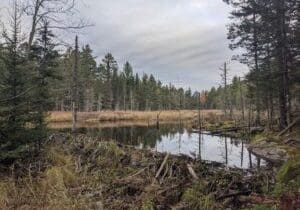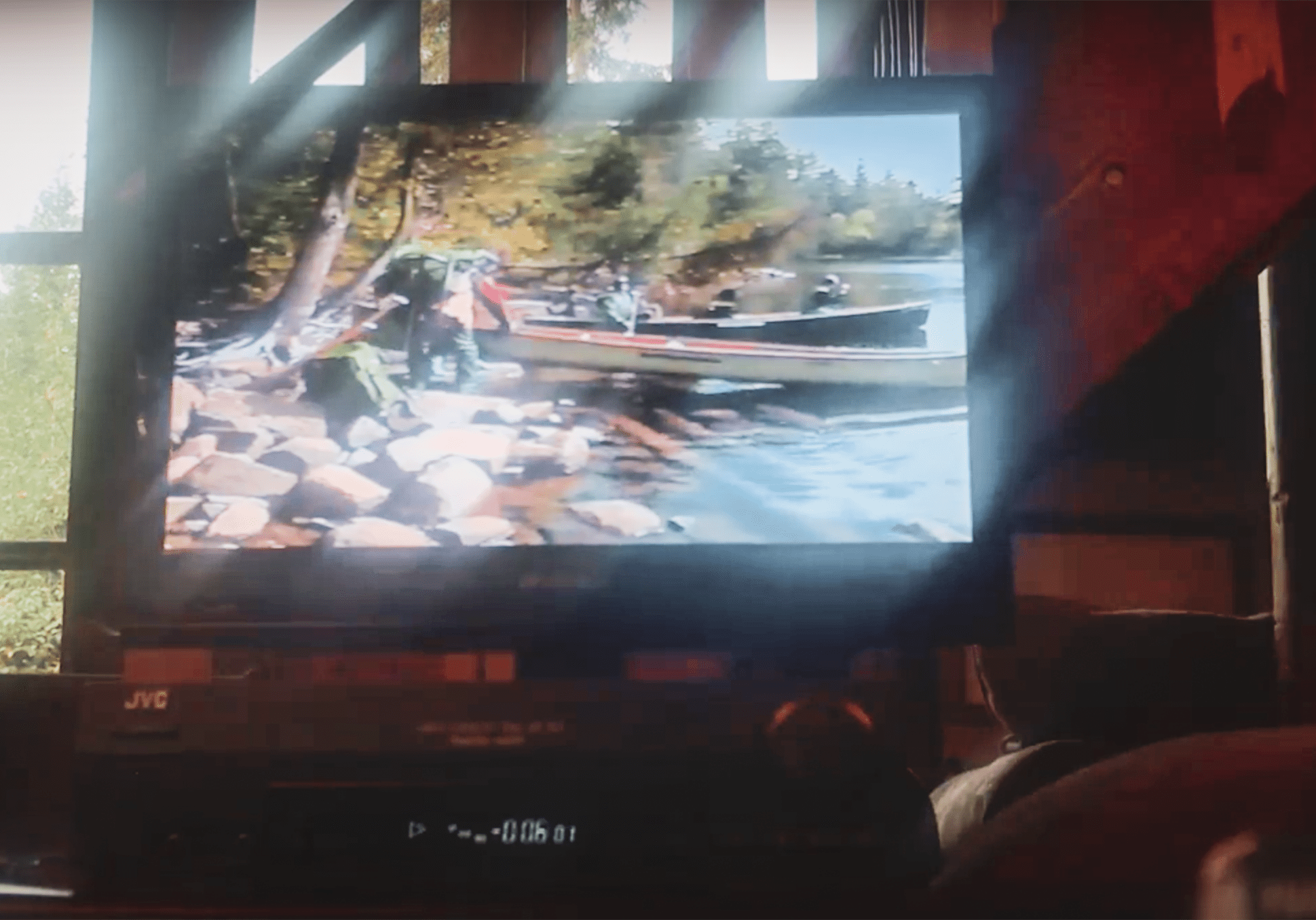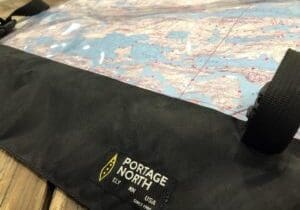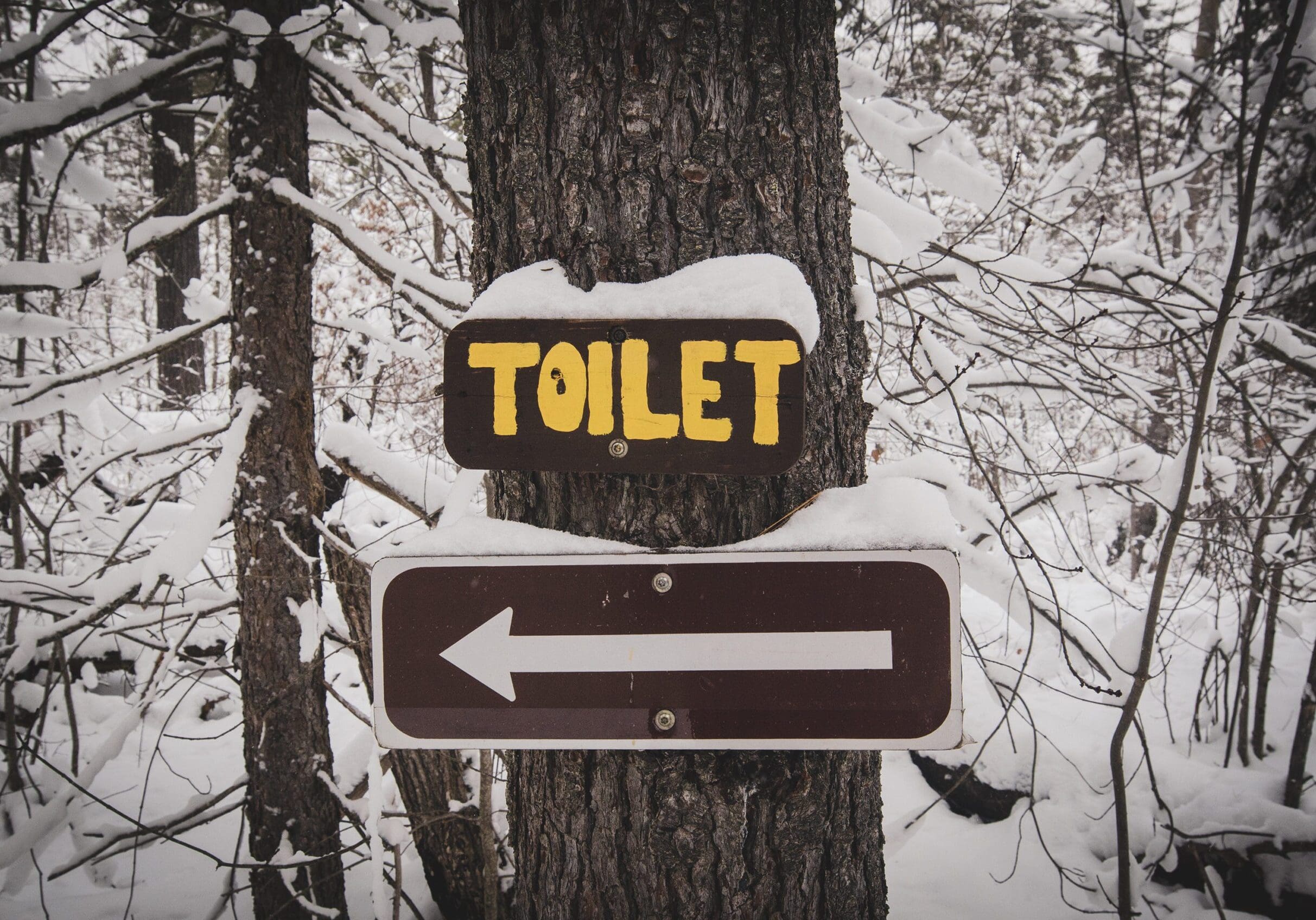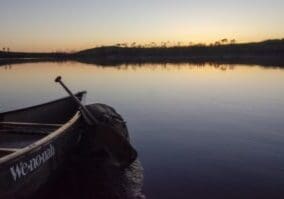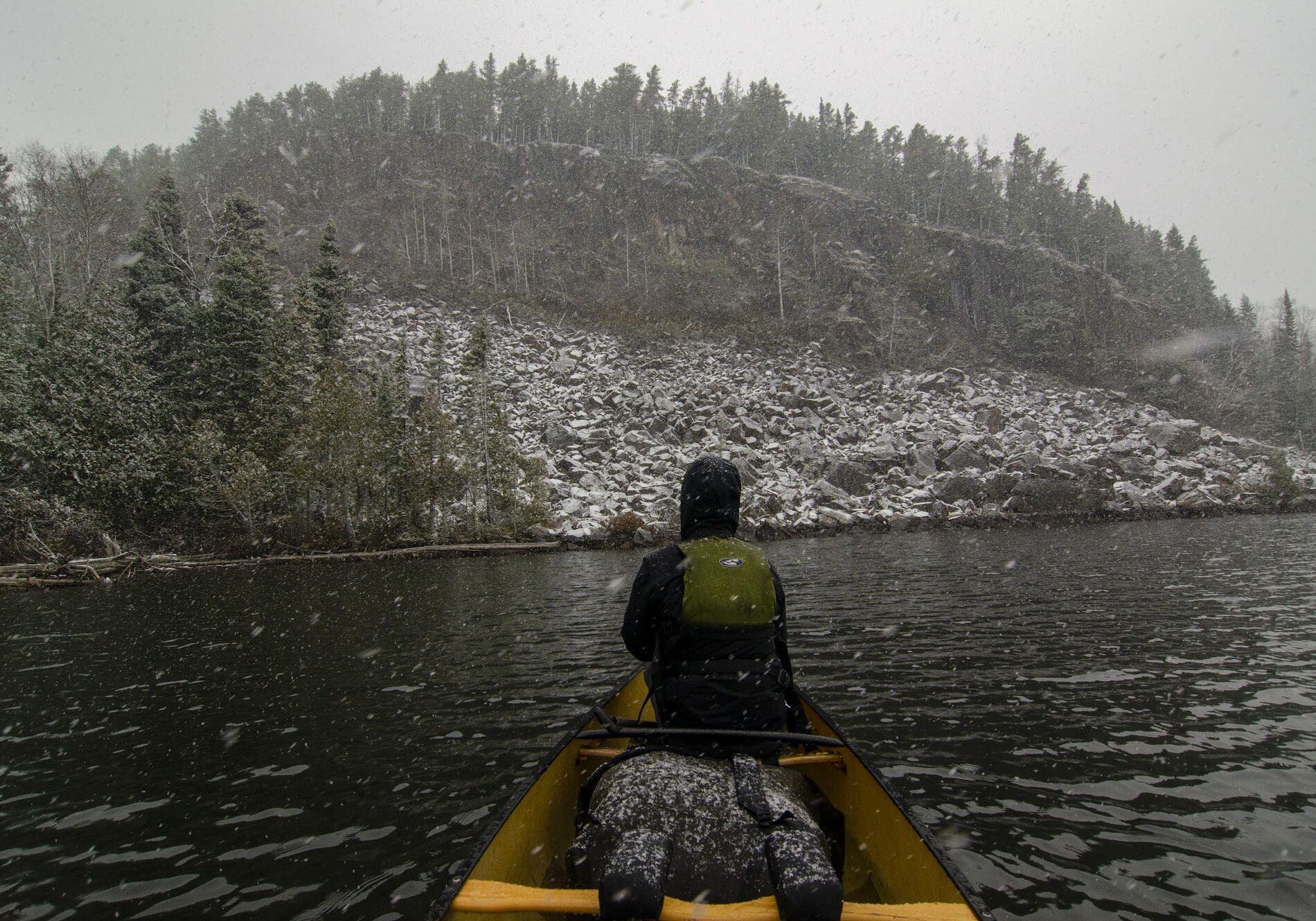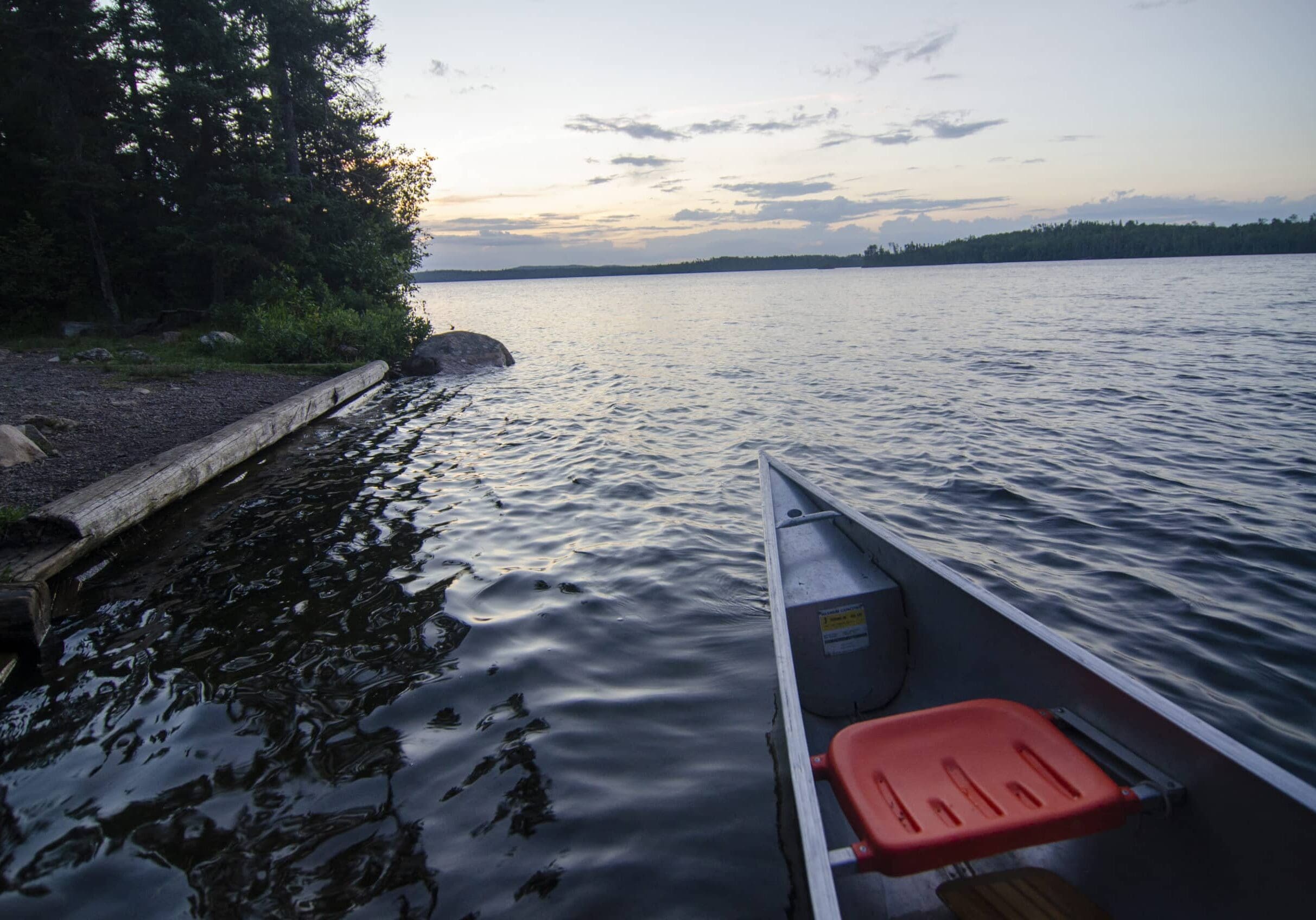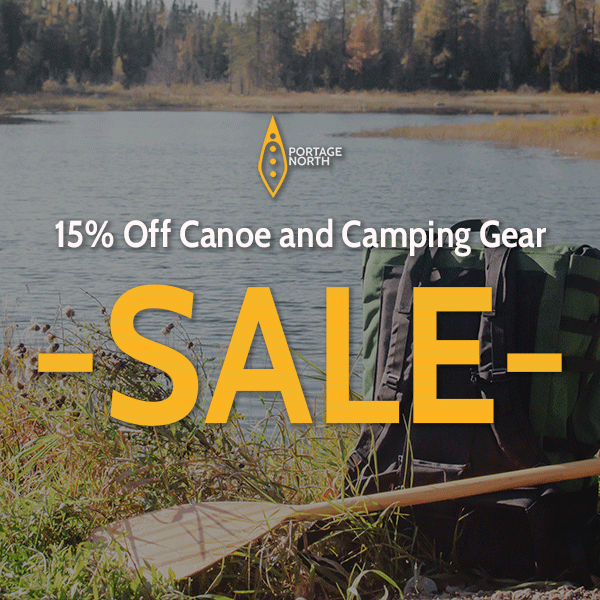The wind howls around the steep rocky palisade displacing snow which softly blanketed the lichen-speckled crag the night before. The cold wind bites the face as the eyes turn upwards towards brilliant hues of pink and orange igniting the morning sky. The evening dark and long makes the dawn all the more magical. And with the sound of the wind driving around rock and through the tree tops being the only sound which fills the ear, another morning met in the heart of wild spaces is a morning well-earned and well-enjoyed.
Winter camping is an acquired taste and as distance travelled or challenges anticipated begin boiling down the creature comforts, it becomes even more so. Many accomplished canoeists or backpackers who thrive in summer months find themselves ill-suited for the winter challenges. But I believe anyone can do winter camping, it just requires a different skill set, a unique mindset, and the right gear to fully enjoy everything the season has to offer. For the person looking to get into winter camping, specifically in large wild spaces like the BWCA for the first time, there is plenty to learn. The best days winter camping are magical. Wild spaces feel even wilder, the scenery becomes surreal, and the sense of accomplishment is unlike any other. But for the person familiar with a summer canoe trip or backpacking adventure, it’s important to understand that even though the best days are amazing, the worst days are that much worse. In the summer, mistakes made or gear forgotten is of fairly low consequence most of the time. Winter has a way of driving home the importance of one’s decisions and the toll for not planning ahead. This shouldn’t scare a person away from the activity but simply create pause in the preparation stages beforehand.
For a person looking to try winter camping for the first time, I highly recommend plugging in with someone who has done it before. As with anything, there are many ways to do an activity, and going with someone with experience helps to avoid some of the painful learning by mistakes which comes with the territory. As you being looking deeper into it, especially accompanying wilderness travel, it’s easy to start getting lost in the gear. There are so many cool gadgets which come with winter activities, but those gadgets come at a price. A person can easily spend $1000 on a sleep setup alone nonetheless the clothes, the travel equipment, the tent, and all of the safety gear. This article is dedicated to how a person on budget can get started with winter camping. What gear should a person spend their money on? What gear can cross over from warm weather season and what gear is specific to winter? Here are seven big things that a person needs specifically for winter and some suggestions about how to get started on a budget. As you become more comfortable with the activity, you’ll begin to discover the benefits about upgrading pieces of your setup and really tailoring in your gear to best suit you.
1) Clothes: Clothes are probably the single easiest item to get good deals on but also one of the easiest places to go wrong. Invest in layers. A massive anorak with a fur ruff is really cool and a necessity for arctic explorers. For a person trying this for the first time, one can get away with less. Layers allow a person to regulate their warmth as they go. Winter can be a very taxing season for movement and unless there’s a hot tent to set up (a tent with a stove, more on that later) it’s quite challenging to get sweaty layers dry. Investing in multiple layers achieves the warmth while also achieving the flexibility to become less warm as you begin to move. As for the materials themselves, wool is an awesome material but it’s expensive. For most people, synthetic base layers do fine. Save the expense for wool for the places it counts: mittens (at least the liners) and socks. Buy a great set of mittens which function in layers. Again a massive set of arctic mittens (or for folks more on a budget, the classic military surplus mittens) are awesome, but make sure they have good layers under them (yes, even for your hands!) If the mittens are so big and warm that they keep your hands cozy, you’ll be taking them off at some point when you need your dexterity, and it’s important your hands don’t completely freeze in the meanwhile. The best outer layer for your body is relatively waterproof, breathable, and yet blocks the wind. For winter in particular, I would prioritize a layer which blocks the wind first since most precip is frozen (snow) and will sluff off. For a person on a budget, the winter jacket is an awesome place to upgrade in the future. Really nice jackets can be had second hand from plenty of sources. This is also a place where great deals can be had on new gear as it goes on clearance. The same can be said for the pants. Good base layers are important and the outer layer should be one that breaks the wind and helps cover the footwear (if you’re using modern boots, traditional mukluks are another story.)
2) Footwear: A good set of winter footwear is at least one size larger than your tennis shoe size, grips well on slippery surfaces, is well insulated, and is relatively waterproof. A shoe which is larger than your normal shoe size is key because too small of footwear begins cutting off circulation once layers of socks are stuffed inside. Once that happens, the layers stop mattering because a foot without adequate blood-flow is going to freeze no matter what. Good traction can be a matter for debate. Some people invest in a relatively inexpensive set of tracks for the boots which adds cleats or spikes for gripping with. This helps a lot, but for folks with sensitive feet can create artificial pressure points over time. There are hundreds of footwear options out there from ultra-modern mountaineering boots to old-school moose hide mukluks. Around here, the gold standard is the muks as they keep the feet warm no matter what. They are a worthwhile investment for someone getting into the activity long-term. If that investment seems like a big one at first, one can spend money on lightly used gear or on military surplus and stay plenty warm. For me, this is one of the first places I would upgrade (after the sleeping set up) because sore, cold feet can leave a person in trouble in a pretty short period.
3) Sleep Set Up: This is the category where everyone seems to have their own methodology. For me, my set up is as follows. I use an inflating, insulated sleeping pad. Purchasing one that is insulated is better since compressed insulation in a sleeping bag is prone to losing tons of heat to the ground. Sometimes when it’s real cold, I pack something reflective like a car windshield sunscreen. Seems crazy, I know, but for relatively little money one can get a material which reflects heat back at the body. This can be a cheap way to up the R-Value. For the sleeping bag itself, layering is again key. I tend to use a cheap old poly-fill bag (in my case, a Coleman 32 degree) with a nice down winter bag inside of it (in my case a -20 Slumberjack Sojourn.) Condensation can be a killer inside a tent at night and down starts losing its insulation value when wet. For me, the synthetic bag adds warmth as it helps trap even more air than the nice bag would on its own. It also helps stop moisture. An argument could also be made for sliding into a bivvy sack even when tenting as essentially a rain jacket for the sleeping bag. From there, I use a homemade fleece liner inside the sleeping bag. Plenty of liners are available and most are there to keep the bag clean only. Adding a fleece layer for me was a way to make the bag feel warm right as you climb in (no warming up the cold shell.) Some people would argue this set-up for numerous well-thought-out reasons, but this is the set up which works for me. As for how to pick out your first set up, I would suggest buying the coldest rated bag you can find, but don’t go for the cheapest. The temperature rating usually is the survivable temp and is not regulated by any one agency. Poly fill will usually be cheaper than down. It’s my opinion that your warmest bag should be at least 0 degrees and layered with a warmer weather bag outside it if possible. This can be a big expense, but a great bag can be had used from outfitters or off the specialty forums. As for the dimensions of the bag itself, be super careful to get a bag that’s large enough for your build with a couple layers on (even if you, like me, plan to sleep in your base layer.) A bag should be long enough for the main bag to get close to your mouth, be able to easily zip up, allow you to roll on your side without popping the zipper open, and have a oversized footbox if possible. Trust me, a bag that’s too small is miserable. And wearing your jacket inside an open bag will always be colder than being sluggly zipped inside an adequate bag. The phrase I like to use is TRUST YOUR GEAR. If you can’t trust your bag to keep you warm 15 degrees or more past the weather forecast without wearing all of your layers, it’s not a warm enough bag. Of all of the categories in this article, this is the one not to skimp out on.
4) Tent/Tarp: I have really learned to love my hot tent. Being able to fire up a stove and get gear dry is a game-changer. But cold tenting is totally feasible and I still do it quite often. For a person trying things for the first time, one of my first suggestions is that you don’t need a hunting base camp tent or a 4-season mountaineering tent. Your normal summer tent can do the trick, just don’t expect it to be glamorous. People getting into winter camping often think that they need a special tent to keep them warm. I’d like to dispel that rumor up front. It’s your sleep set up’s job to keep you warm, it’s the tent’s job to keep you out of the elements. A tent can keep you warm, especially a tent with a stove, but you will never be comfortable unless your sleeping bag and pad are doing the majority of the insulating. Cold tenting is a challenging balance between ventilation and protection. Many mountaineering tents emphasize the latter since whipping mountain winds would utterly destroy a dome tent. However, the catch to poor ventilation in cold weather is a build up of condensation inside of the rainfly which can turn to rain inside of the tent by morning. If the weather allows, a tent which can breathe is perfect in preventing this. From a budgetary standpoint though, a person just getting into wilderness travel in the winter is fine with ANY tent. Some tents don’t handle snow loads well, so be wary of that. Staking tents may actually be easier in the winter than in the summer since any buried object can become a snow anchor. And the ability to camp on the ice means an ever flat tent pad (if you don’t make the cardinal mistake of stomping a bunch of holes in your tent pad first.) One consideration I will offer in tent selection though: make sure it’s easy to set up and take down and be aware of anything which might freeze up. Tents with lots of clips for attaching the body to the poles can be challenging in deep cold when the hands start losing their function. Sleeves sewn into the body are easier. And loops at the end of the rainfly which grommet over the end of the tent pole are less risky than a buckle which can freeze up if left in the snow. Also, be aware that winter gear is bulky. Getting a 50% larger tent for winter than you would use in summer is not overkill. All of these challenges can be overcome though to allow most tent/tarp setups to work.
5) Travel Method: For extended, human-powered wilderness travel there are really two options: ski or snowshoe. Sure a person could go on foot, but post-holing is a perfect way not to go anywhere. For the average person who isn’t a skiing specialist, I would recommend starting with snowshoes. Skis require strength and balance which becomes even harder with gear. For snowshoes, there are seemingly endless options when it comes to what to purchase. When you get into the activity more, the nuances become more important. For the person trying it for the first time, I offer this rule: simplicity first. There are a lot of really unique options, but if a snowshoe breaks in the backcountry and is unrepairable, you’re in big trouble. For someone trying it for the first time, I would recommend the largest set of modern snowshoes you can find. Classics are amazing and I prefer them on open lake ice when slush can really clog up the undersides of a spiked-modern set. However, classic snowshoes require lots of maintenance and can be temperamental in the field. There are lots of things that can go wrong and break. However, classics are also made of materials than can often be repaired (at least temporarily) in field, it just takes some ingenuity. They are usually expensive up front though. A lot of modern snowshoes on the other hand are too small to allow a person to walk on anything but reasonably packed snow, so get something bigger if possible. Style wise, there are a few things to look for. The best styles are ones which can either keep functioning if broken or can be easily fixed in the field. Some of the modern, one-piece plastic ones fit this rule well. A bunch of the older aluminum-framed ones which are laced onto the frame are great as well since just a little paracord can fix them. Avoid ones which are attached to a frame with a solid piece of plastic or other body material. If that tore out, drilling would be required to tie it back on. Also, for overnight travel, avoid any bindings which require a complicated ratchet system. These can become caked with snow and frozen up which is very difficult to clear up in the field. That said, no one pair of snowshoes is perfect. I tend to bring two sets with me on my wilderness trips: a large classic set for lake travel and a small modern set for steep trails. Keep that in mind, and weigh the pros and cons for the type of trip you’re seeking after before you purchase your first set of snowshoes.
6) Cargo: Another major consideration is how you’ll be moving your gear from A to B. Winter gear can be bulky and heavy. Often time the best mode of travel is a pulk sled pulled behind you. But what sled to get? What bags to use? How should I hook it to my person? For the sled itself, I would recommend a plastic ice fishing sled for a person trying this for the first time since there is a lot of forgiveness to plastic. It doesn’t require care or maintenance and is really cheap in comparison. A nice wooden toboggan is beautiful and pulls efficiently but it needs a lot of work to get to that point and a significant up-front expense. This can be a worthwhile investment for someone doing this activity often, but for the first time it’s a bit out of reach. As for the bags inside the sled, it’s imperative that the gear is well tied down and contained. Loose items in a sled will soon be lost items in the snow. A specialized sled bag is amazing, one that ties nicely into a toboggan or sled, but the easiest solution is using summer portage packs. They are large, durable, and multi-purposed. They are also made for dragging through the mud and water so a bunch of snow piling up on top of them won’t hurt the gear. A good portage pack is also flexible which allows it to be more easily tied down into a sled than a backpacking pack with a frame. And as for the person, a long line with a long enough lead from the sled to the person is key. I like a long lead when out on a lake and shorten it up on portages for more control. From there, a good hip belt, which has appropriate cushioning will allow you to pull heavy weight all day long. A good line and a good pulk hip belt are not big ticket items but are a worthwhile investment since they connect with the most physical part of the experience.
7) Cooking Set Up: This is one lesson that can be especially painful to learn. The average wanna-be wilderness explorer can easily be pulled into the romanticism of sitting out in the snow around an open fire. In actuality, campfires can be way tougher to start in winter and can be a tough choice for cooking since an exposed fire is incredibly inefficient at heat loss (in winter with possibly frozen food this becomes even more challenging.) Stoves too become difficult as many fuel types such as certain mixes of the Iso-Butane stop functioning below certain temperature thresholds and some stove mechanisms can start to freeze up if they get at all wet. Lighters also cease to work at cold temps and matches can sometimes be difficult with numb hands. Come prepared with lots of backup fire-starting options as winter can be unpredictable. Be prepared also with multiple cooking options since an inoperable stove can be a game changer. Check your fuel choices so that they are functional well below your expected temperatures. I can tell you from experience that semi-frozen, non-hydrated backpacker meals really put a damper on dinner plans!
Finally, it’s important to underscore that weight matters less in this season. If you are pulling a good sled, the extra few pounds for an extra layer or an extra fire starting method are worth it. This is not a season to experiment with ultra-lighting things since nature has a way of re-teaching the importance of coming prepared. Make smart decisions to bring the gear that you need for a good experience. And don’t blame bad planning or a turn in the weather entirely on your set up! A person with the best gear can still have a trip turn sour. As you head further into the world of winter wilderness tripping, you’ll begin fine tuning your set up and probably making jumps into higher quality gear, but it is possible to get into this activity on a budget. It might not always be as glamorous, and there will be days where you’re cursing the damp feet or the sleeping bag which doesn’t zip quite as far closed as you would like it to. That’s part of the story and a valuable lesson for every adventure still to come.
Sign up for our newsletter to receive updates about new articles, great deals, and information about the activities you love and the gear that makes them possible:
Have You Read Our Other Content?
A Wilderness of the People – The 2023 Boundary Waters Canoe Area Wilderness Situational Assessment
The June 28th USFS newsletter contained the results of a six-month-long survey with confidential feedback from 100 individuals representing a wide scope of BWCAW users, affiliated businesses, nonprofits, and managing agencies. Their survey delved deep into the complexities of managing America’s busiest, and often one of the most complicated and controversial, wilderness areas. The results…
Three Generations of BWCAW Rules Videos – Side by Side
It’s as ubiquitous of an experience as one can find tied to a canoe trip into the Boundary Waters, and the memories of it are deeply rooted in my childhood as they are for many who make the annual pilgrimage north to paddle the border waters of canoe country. Even now, I can close my…
How to Name Over 1000 Different Lakes – The BWCA
The Boundary Waters have seemingly endless lakes bearing names from Ojibwe, French, English, or English mistranslations, misspellings, or honest translations of the Ojibwe. Many have fascinating backstories of how they came by their names. Some lakes have seemingly had the same name as long as time can remember while others have switched multiple times. This…
What’s Old is New Again on Chapman St. – Ely, MN
Summer is nearly upon us and the streets of Ely are bustling with canoeists, campers, and fishermen eager to enjoy their trips to the BWCA. Hopefully we’ll talk with many of them at Portage North and Sundog Sports in our new and improved retail space which we look to reopen sometime this June. And as…
10 Tips and Tricks for Nightime Canoe Travel
The vast majority of BWCA visitors paddle and hike during daylight hours and for good reason. It’s safer, there’s more to see, and daylight travel aligns with normal sleep cycles. Night travel, on the other hand, provides a higher risk of getting lost while paddling; it’s also easier to fall and get hurt while portaging.…
How to Start Wilderness Winter Camping on a Budget
The wind howls around the steep rocky palisade displacing snow which softly blanketed the lichen-speckled crag the night before. The cold wind bites the face as the eyes turn upwards towards brilliant hues of pink and orange igniting the morning sky. The evening dark and long makes the dawn all the more magical. And with…
Map Mondays – Week 7 – Larch Creek to Brule Lake
As part of our continuing series on the “route planning game,” we are creating routes using randomly selected entry points, exit points, and number of days to create unique and fun BWCA routes. Let’s check it out! Total Mileage: 52.5 milesNights: 6Paddle Distance: 42.8 milesPortage Distance: 9.7 miles Day 1: Miles: 13.6Target Campsite: Saganaga Lake,…

